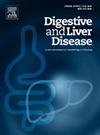Feasibility and effectiveness of liver transplantation following immunotherapy in patients with hepatocellular carcinoma
IF 4
3区 医学
Q1 GASTROENTEROLOGY & HEPATOLOGY
引用次数: 0
Abstract
Introduction
Immunotherapy is an attractive strategy for downstaging/bridging hepatocellular carcinoma (HCC) to liver transplantation (LT).
Aims
This multicenter study reports the results of HCC-transplanted patients in ten French liver transplant centers in this context.
Patients and Methods
Clinical, biological, and radiological data were collected for each patient at the beginning and end of immunotherapy and before LT. The primary endpoint was the tolerance and effectiveness of LT.
Results
Twenty-one patients [majority of men (17/21); median age 62 years (57-64), BCLC B stage in 14/21 patients (66.7%)] who underwent LT for HCC after immunotherapy were included. HCC was multi-nodular in 17/21 (81%) cases, with a median size of the largest nodule of 36 mm (21-60). Thirteen patients had an AFP score >2 (downstaging group) and 8 of ≤2 (bridging group). Patients in the downstaging group were beyond Milan criteria, and 3 in the bridging group (p=0.006). Sixteen patients (76.2%) received Atezolizumab/Bevacizumab during 8.5 cycles (4.7-14). At the end of immunotherapy, most patients shifted to an early/intermediate BCLC stage (p=0.001) and reached Milan criteria (57.1%, p=0.023). The AFP score remained >2 in 2 cases (9.5%) (p=0.003). The median interval between the last immunotherapy cycle and LT was 5.1 (2.7-9.3) months. All patients except 3 received standard immunosuppressive treatment. Two cases (10%) of rejection occurred, resolved after increasing immunosuppression. Early serious adverse events occurred in 6 patients (28.5%), 5 being fatal (27%). Two patients (10.5%) had an HCC recurrence post-LT. On explant pathology, no residual tumor was detected in 6 cases (28.6%) and partial necrosis in 7 (41.2%). The R3-AFP score stratified patients into 3 at very low (14.3%), 8 at low (38.1%), and 10 at high (47.6%) recurrence risk.
Conclusion
LT following immunotherapy is feasible in selected patients with HCC and has an acceptable risk of rejection. However, the high immediate mortality observed requires further exploration in prospective studies.
求助全文
约1分钟内获得全文
求助全文
来源期刊

Digestive and Liver Disease
医学-胃肠肝病学
CiteScore
6.10
自引率
2.20%
发文量
632
审稿时长
19 days
期刊介绍:
Digestive and Liver Disease is an international journal of Gastroenterology and Hepatology. It is the official journal of Italian Association for the Study of the Liver (AISF); Italian Association for the Study of the Pancreas (AISP); Italian Association for Digestive Endoscopy (SIED); Italian Association for Hospital Gastroenterologists and Digestive Endoscopists (AIGO); Italian Society of Gastroenterology (SIGE); Italian Society of Pediatric Gastroenterology and Hepatology (SIGENP) and Italian Group for the Study of Inflammatory Bowel Disease (IG-IBD).
Digestive and Liver Disease publishes papers on basic and clinical research in the field of gastroenterology and hepatology.
Contributions consist of:
Original Papers
Correspondence to the Editor
Editorials, Reviews and Special Articles
Progress Reports
Image of the Month
Congress Proceedings
Symposia and Mini-symposia.
 求助内容:
求助内容: 应助结果提醒方式:
应助结果提醒方式:


